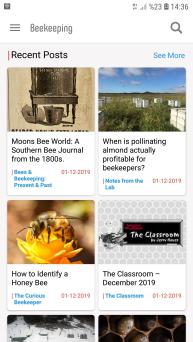About this app
What is Beekeeping App ?
Hive inspectionBeekeeping (apiculture) is the practice of managing honeybee colonies to attain desired objectives. The most common primary objectives for managing colonies are to:
Ensure large, healthy adult honeybee populations to coincide with major nectar flows;
To use these strong honeybee colonies to best execute the beekeeping management plan to:
Maximize the collection of nectar (ie. to maximize honey production); and/or
Provide pollination services for local food crops.
Some beekeepers have other objectives for their honeybee colonies such as:
Raising honeybee livestock for sale to other beekeepers;
Producing other honeybee substances, including bee pollen, propolis, and royal jelly.
Planning is Key
In order to attain the desired results, be it honey production, pollination services, or other goals, the beekeeper needs a plan. The fundamental elements that drive the plan are:
Knowledge of local nectar flows. This knowledge is critical in that it tells the beekeeper which crops provide nectar and pollen for the honeybees, when the nectar flows occur, where the crops are located, and how prolific they are. This also provides timing for moving honeybee colonies into and out of fields for pollinating various food crops for growers. This knowledge not only gives the timing for maximizing the strength of colonies to take advantage of nectar flows, but also identifies times when there will be a shortage of food for the bees.
Knowledge of honeybee biology. The beekeeper must understand the natural instincts of the honeybee in order to facilitate an environment to enhance the productivity of the colony. Honeybees are social insects and thus the beekeeper must manage honeybee colonies as opposed to managing at the individual bee level. To do this, the beekeeper must have a good knowledge of the honeybee life cycle, seasonal cycles of the honeybee colony, the roles of of the different types of bees, and honeybee diseases. Since most of the beekeeper's objectives revolve around honeybees collecting nectar, knowledge of the food requirements of the colony, and how the bees collect and process food, is critical.
Beekeeping techniques to manipulate the colony. There are a number of basic beekeeping techniques that are used to ensure good colony health, and to maximize colony strength at the desired times. Management techniques do vary somewhat, and are fined tuned to the conditions in particular regions.
Deciding on the goals and how to best use the colonies. Given the local nectar flows, pollination opportunities, and the price of honey, the beekeeper must make a plan as to how to best manage the colonies to achieve the desired objectives.
Beekeeping Tools and Equipment
Hive assemblyBasic Hive Equipment
Modern honeybee colonies are designed to mimic the dimensions and environment of a bees nest built naturally by wild (feral) honeybees, with the added ability to remove individual frames of honeycomb for inspection and manipulation. The dimensions of the removable frames are similar in dimension to honeycomb built in the wild. One notable feature is that the space between each frame, known as the "bee space", is approx 8 mm. This space is sufficient for the bees to move around but not big enough so that the bees will build additional honeycomb in the space, thus facilitating easy removal of the frames.
A standard bee hive consists of:
One bottom board
One or two brood chambers (each containing 9 or 10 removable frames)
One queen excluder (to prevent the queen from moving from the brood chamber to the honey supers)
One or more honey supers (boxes each containing 9 or 10 removable frames)
One inner cover
One telescoping hive cover
Basic beekeeping toolsBeekeeper's Tools
The essential tools required by a beekeeper to manipulate honeybee colonies are:
Smoker
Hive tool
Bee veil
Some beekeepers additionally may use a full bee suit with gloves, and a bee brush.
App Permissions
Allows applications to open network sockets.
Allows applications to access information about networks.
Allows read only access to phone state, including the phone number of the device, current cellular network information, the status of any ongoing calls, and a list of any PhoneAccounts registered on the device.
Allows access to the vibrator.
Allows using PowerManager WakeLocks to keep processor from sleeping or screen from dimming.
Allows an application to receive the ACTION_BOOT_COMPLETED that is broadcast after the system finishes booting.

